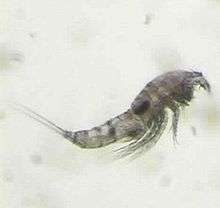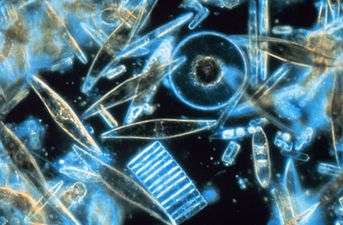Harpacticoida
Harpacticoida is an order of copepods, in the subphylum Crustacea. This order comprises 463 genera and about 3,000 species; its members are benthic copepods found throughout the world in the marine environment (most families) and in fresh water (essentially the Ameiridae, Parastenocarididae and the Canthocamptidae). A few of them are planktonic or live in association with other organisms. Harpacticoida represents the second-largest meiofaunal group in marine sediment milieu, after nematodes. In Arctic and Antarctic seas, Harpacticoida are common inhabitants of sea ice. The name Harpacticoida comes from the Greek noun harpacticon (rapacious predator) and the suffix -oid (akin to) and means reminiscent of a predator .
| Harpacticoida | |
|---|---|
 | |
| Harpacticoid copepod | |
| Scientific classification | |
| Kingdom: | |
| Phylum: | |
| Subphylum: | |
| Class: | |
| Subclass: | |
| Order: | Harpacticoida G. O. Sars, 1903 |
| Families | |
|
See text | |
Harpacticoids are distinguished from other copepods by the presence of only a very short pair of first antennae. The second pair of antennae are biramous, and the major joint within the body is located between the fourth and fifth body segments. They typically have a wide abdomen, and often have a somewhat worm-like body.[1]
Families
65 families are currently recognised in the Harpacticoida:[2]
- Adenopleurellidae
- Aegisthidae
- Ameiridae
- Ancorabolidae
- Arenopontiidae
- Argestidae
- Balaenophilidae
- Cancrincolidae
- Canthocamptidae
- Canuellidae
- Cerviniidae
- Chappuisiidae
- Cletodidae
- Cletopsyllidae
- Clytemnestridae
- Cristacoxidae
- Cylindropsyllidae
- Dactylopusiidae
- Danielsseniidae
- Darcythompsoniidae
- Ectinosomatidae
- Euterpinidae
- Hamondiidae
- Harpacticidae
- Heteropsyllidae
- Huntemanniidae
- Idyanthidae
- Ismardiidae
- Laophontidae
- Laophontopsidae
- Latiremidae
- Leptastacidae
- Leptopontiidae
- Longipediidae
- Louriniidae
- Metahuntemanniidae
- Metidae
- Miraciidae
- Neobradyidae
- Normanellidae
- Novocriniidae
- Orthopsyllidae
- Parameiropsidae
- Paramesochridae
- Paranannopidae
- Parastenheliidae
- Parastenocarididae
- Parastentheliidae
- Peltidiidae
- Phyllognathopodidae
- Porcellidiidae
- Protolatiremidae
- Pseudotachidiidae
- Rhizothricidae
- Rhynchothalestridae
- Rometidae
- Rotundiclipeidae
- Superornatiremidae
- Tachidiidae
- Tegastidae
- Tetragonicipitidae
- Thalestridae
- Thompsonulidae
- Tisbidae
- Zosimidae
References
- Robert D. Barnes (1982). Invertebrate Zoology. Philadelphia, PA: Holt-Saunders International. p. 692. ISBN 978-0-03-056747-6.
- Geoff Boxshall (2010). "Harpacticoida". WoRMS. World Register of Marine Species. Retrieved May 22, 2010.
External links
| Wikimedia Commons has media related to Harpacticoida. |
- Harpacticoida, Guide to the marine zooplankton of south eastern Australia, Tasmanian Aquaculture and Fisheries Institute

